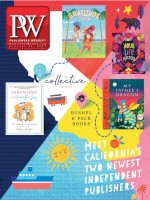Krys Malcolm Belc’s The Natural Mother of the Child (Counterpoint, June) takes its title from the legal designation assigned to him—a nonbinary, transmasculine parent—after he gave birth to his son. The book, a series of essays punctuated by visual elements and official documentation, details the mundane, often Sisyphean, tasks of caregiving, and also examines Belc’s ambivalence toward the types of stories that trans families have been able to tell. He spoke with PW about these prescribed narratives, his craft choices, and upending genre conventions.
What compelled you to write this memoir?
I was writing two sets of essays. One was a compare-and-contrast of my mother and my mother-in-law. They were central figures in my young adult life, and [becoming a parent] gave me more insight into them as people. The other collection was about my body and my experience of embodiment. The concept of motherhood was the undercurrent that tied them together. I had a more cohesive thing going on than I had previously thought, and that’s where the book came from.
Why did you incorporate images and other materials into your text?
Anyone who is writing a book is writing with and against [other] books. A lot of trans memoirs tend to be organized in a linear fashion, which has to do with what the market was open to. Those kinds of books are amazing, but I don’t identify with the way that they’re structured. I looked to books like Don’t Let Me Be Lonely by Claudia Rankine, The Argonauts by Maggie Nelson, Are You My Mother? by Alison Bechdel, and W.G. Sebald’s novels—books that explicitly examine memory and the interplay between texts and image. I thought about how these writers use images and fragments, and what they’re doing with memories, and I then asked myself, “How can I tell a story about a trans person’s family using these techniques?”
What do you hope readers take away from your book?
I’m trying to take the reader on an experience that involves reactions to visual stimuli, to microaggressions and to small good things, and to interesting images. I want it to be more of an experience. One of the most humanizing things that a book by a marginalized person can do is have a variety of things in it: uncertainty and certainty, good decisions and bad decisions. A person can still be a legitimate trans person and talk about their experience.
How do you see your book in conversation with other parenting memoirs?
The things that I write about—a lot of it is these mundane parenting things—have very broad appeal. I feel like there’s a separation of queer and trans writing from the family life. The default expertise of what it means to be a parent to young children seems to be [that of] a white, middle-class woman. I’m a parent who is not a mom, and not in the fatherhood realm, but somewhere in between those things. It’s challenging to explore the boundaries between these binary ideas of parenting, but there’s room for people who are pushing against the boundaries a little bit. The image of the transgender dad as more than just a theoretical thing makes a lot of people really angry. I like the idea that my book would challenge people about who gets to participate in these conversations.



 Volume 268
Issue 2
01/11/2021
Volume 268
Issue 2
01/11/2021





